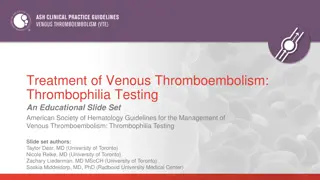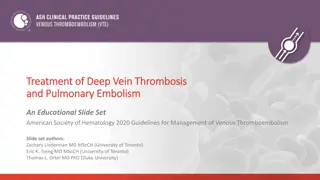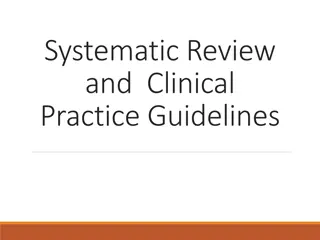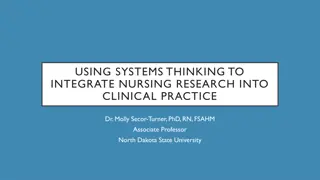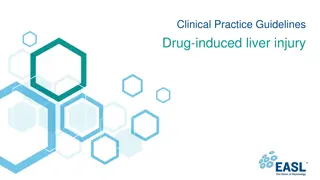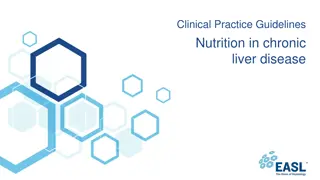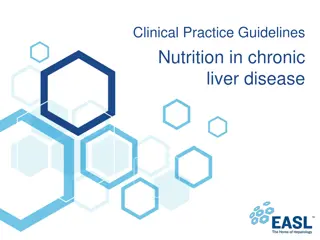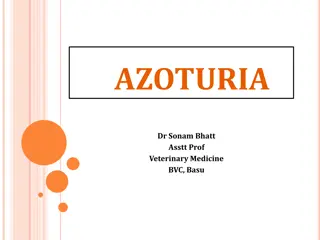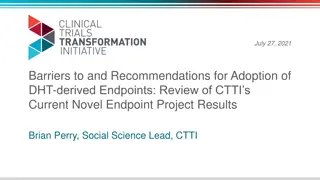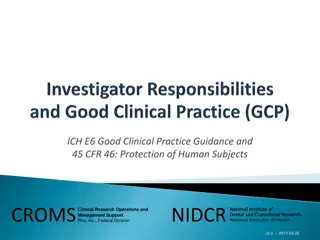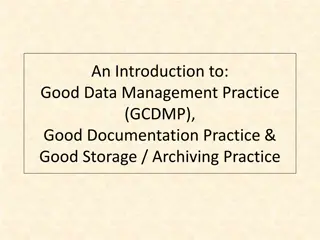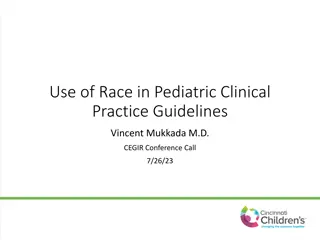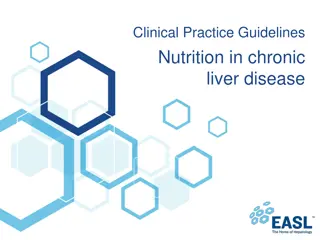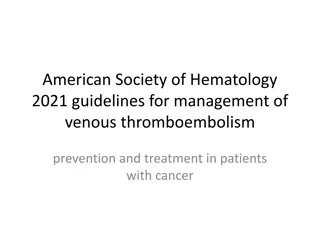Clinical Practice Guidelines for Rhabdomyolysis: Management and Recommendations
Rhabdomyolysis is a condition with a significant impact on kidney function, requiring prompt clinical management to prevent morbidity and mortality. This article discusses the prevalence, patient population criteria, admission criteria, treatment options, and potential complications associated with rhabdomyolysis. It emphasizes the importance of early intervention, particularly with intravenous fluid administration, to prevent renal failure. By following standardized care guidelines, healthcare providers can effectively manage rhabdomyolysis cases and improve patient outcomes.
Download Presentation

Please find below an Image/Link to download the presentation.
The content on the website is provided AS IS for your information and personal use only. It may not be sold, licensed, or shared on other websites without obtaining consent from the author.If you encounter any issues during the download, it is possible that the publisher has removed the file from their server.
You are allowed to download the files provided on this website for personal or commercial use, subject to the condition that they are used lawfully. All files are the property of their respective owners.
The content on the website is provided AS IS for your information and personal use only. It may not be sold, licensed, or shared on other websites without obtaining consent from the author.
E N D
Presentation Transcript
Banner Clinical Practice: Rhabdomyolysis ZACHARY SPRAGUE, DO BETHANY BRUZZI, DO JUNE 7, 2018
Prevalence United Stated: approximately 26,000 cases annually Approximately 7 to 10% of all cases of acute kidney injury in the United States are due to myoglobinuria associated AKI. The incident of AKI in rhabdomyolysis has been reports to range between 13 to 50% but is difficult to establish a true rate due to varying definitions and clinical scenarios
Why Do We Need a Standard of Care? The primary purpose of these guidelines is to decrease morbidity and mortality rates of rhabdomyolysis by presenting recommendations for clinical management that can be applied to individual cases if deemed appropriate by the treating physician.
Patient Population Inclusion Criteria Adults great than 18 years of age Signs and symptoms (H&P) consistent with diagnosis of Rhabdomyolysis Exclusion Criteria Younger than 18 years of age History of End Stage Renal Disease History of Chronic Heart Failure
Admission Criteria 1. Creatinine Kinase greater than five times the upper limit of normal6(Observation is appropriate for anyone who meets greater than 5x upper limit normal (1000) to 5000, and did not correct despites IV fluids. Admit to inpatient if greater than 10K. Consider Inpatient status for anyone 5001-9999 and rising.) 2. Continuously increasing CK despite intravenous fluid protocol 3. Laboratory finding consistent with AKI or electrolyte abnormalities(such ranges that would warrant obs/inpt for those diagnosis (ex) creatinine at least 1.5x baseline) 4. Concern for oliguria(<0.5 ml of urine per kilogram per hour for 12 hours), anuria, or volume overload 5. Need for Renal Replacement Therapy 6. Clinical signs of compartment syndrome
Treatment Intravenous Fluids: Intravenous hydration should be initiated immediately upon clinical suspicion as the delay of treatment can lead to oliguric renal failure and eventually anuric renal failure.13An initial 1-2L bolus of normal saline should be given followed by a intravenous fluid rate of 400ml/hr titrated to a urine output of 200-300ml/hr.6,31 Mannitol and Loop diuretics are not effective
Complications AKI/ARF Hyperkalemia Hypocalcemia and hypercalcemia Hyperphosphatemia Hyperuricemia Hypovolemia
Discharge Criteria ED 1. Creatinine Kinase downtrending 2. Creatine Kinase less than 1,000. 3. Urine dipstick negative for blood 6(Unlikely to be positive with values less than 1000, if high pos on dipstick, may consider observation with risk of increased values though rather than discharge) 4. Electrolytes within normal ranges 5. No clinical signs of compartment syndrome 6. Clinically euvolemic
Discharge Criteria Medicine 1. Creatinine Kinase downtrending 2. Creatine Kinase less than 10,0009,15,36 3. Urine dipstick negative for blood 6 4. Electrolytes within normal ranges 5. No clinical signs of compartment syndrome 6. Clinically euvolemic
References Abassi ZA, Hoffman A, Better OS. Acute renal failure complicating muscle crush injury. Semin Nephrol. 1998;18:558 65. Akmal M, Bishop JE, Telfer N, et al. Hypocalcemia and hypercalcemia in patients with rhabdomyolysis with and without acute renal failure. J Clin Endocrinol Metab 1986; 63:137. Allison RC, Bedsole DL. The other medical causes of rhabdomyolysis. Am J Med Sci 2003;326:79-88. Bagley WH, Yang H, Shah KH. Rhabdomyolysis. Intern Emerg Med 2007;2:210-8. Blanco JR, Zabalza M, Salcedo J, et al. Rhabdomyolysis of infectious and noninfectious causes. South Med J 2002; 95:542. Bosch X, Poch E, Grau JM. Rhabdomyolysis and acute kidney injury. N Engl J Med 2009; 361:62. Brown CV, Rhee P, Chan L, et al. Preventing renal failure in patients with rhabdomyolysis: do bicarbonate and mannitol make a difference? J Trauma 2004; 56:1191. Bywaters EG, Beall D. Crush Injuries with Impairment of Renal Function. Br Med J 1941; 1:427. Cho YS, Lim H, Kim SH. Comparison of lactated Ringer s solution and 0.9% saline in the treatment of rhabdomyolysis induced by doxylamine intoxication. Emerg Med J 2007;24:276-80. de Meijer AR, Fikkers BG, de Keijzer MH, et al. Serum creatine kinase as predictor of clinical course in rhabdomyolysis: a 5- year intensive care survey. Intensive Care Med 2003; 29:1121.
References Gabow PA, Kaehny WD, Kelleher SP. The spectrum of rhabdomyolysis. Medicine (Baltimore) 1982; 61:141. Giannoglou GD, Chatzizisis YS, Misirli G. The syndrome of rhabdomyolysis: Pathophysiology and diagnosis. Eur J Intern Med 2007; 18:90. Gunal AI, Celiker H, Dogukan A, et al. Early and vigorous fluid resuscitation prevents acute renal failure in the crush victims of catastrophic earthquakes. J Am Soc Nephrol 2004; 15:1862. Harper J. Rhabdomyolysis and myoglobinuric renal failure. Crit Care Nurse. 1990;10(3):32 6. Hatamizadeh P, Najafi I, Vanholder R, et al. Epidemiologic aspects of the Bam earthquake in Iran: the nephrologic perspective. Am J Kidney Dis 2006; 47:428. Hojs R, Ekart R, Sinkovic A, Hojs-Fabjan T. Rhabdomyolysis and acute renal failure in intensive care unit. Ren Fail. 1999;21:675 84. Holt S, Moore K. Pathogenesis of renal failure in rhabdomyolysis: the role of myoglobin. Exp Nephrol 2000; 8:72. Homsi E, Barreiro MF, Orlando JM, Higa EM. Prophylaxis of acute renal failure in patients with rhabdomyolysis. Ren Fail 1997; 19:283. Huerta-Alard n AL, Varon J, Marik PE. Bench-to-bedside review: Rhabdomyolysis -- an overview for clinicians. Crit Care 2005; 9:158. Khan FY. Rhabdomyolysis: a review of the literature. Neth J Med 2009; 67:272.
References Knochel JP. Mechanisms of rhabdomyolysis. Curr Opin Rheumatol. 1993;5:725 31. Knochel JP. Rhabdomyolysis and myoglobinuria. Annu Rev Med 1982; 33:435. Lameire N, Vanholder R, Van Biesen W. Loop diuretics for patients with acute renal failure: helpful or harmful? JAMA 2002; 288:2599. Llach F, Felsenfeld AJ, Haussler MR. The pathophysiology of altered calcium metabolism in rhabdomyolysis-induced acute renal failure. Interactions of parathyroid hormone, 25-hydroxycholecalciferol, and 1,25-dihydroxycholecalciferol. N Engl J Med 1981; 305:117. Malik GH. Rhabdomyolysis and Myoglobin-induced Acute Renal Failure. Saudi J Kidney Dis Transpl 1998; 9:273. McMahon GM, Zeng X, Waikar SS. A risk prediction score for kidney failure or mortality in rhabdomyolysis. JAMA Intern Med 2013; 173:1821. Mehta RL, Pascual MT, Soroko S, et al. Diuretics, mortality, and nonrecovery of renal function in acute renal failure. JAMA 2002; 288:2547. Melli G, Chaudhry V, Cornblath DR. Rhabdomyolysis: an evaluation of 475 hospitalized patients. Medicine (Baltimore) 2005; 84:377. Mikkelsen TS, Toft P. Prognostic value, kinetics and effect of CVVHDF on serum of the myoglobin and creatine kinase in critically ill patients with rhabdomyolysis. Acta Anaesthesiol Scand 2005; 49:859. Ron D, Taitelman U, Michaelson M, Bar-Joseph G, Bursztein S, Better OS. Prevention of acute renal failure in traumatic rhabdomyolysis. Arch Intern Med 1984; 144:277-80.
References Sauret JM, Wang GK. Rhabdomyolysis. American Family Physician 2002 Mar 1; 65(5):907-913 Sever MS, Vanholder R, Lameire N. Management of crush-related injuries after disasters. N Engl J Med 2006; 354:1052. Slater MS, Mullins RJ. Rhabdomyolysis and myoglobinuric renal failure in trauma and surgical patients: a review. J Am Coll Surg 1998; 186:693. Vanholder R, Sever MS, Erek E, Lameire N. Acute renal failure related to the crush syndrome: towards an era of seismo- nephrology? Nephrol Dial Transplant 2000; 15:1517. Vanholder R, Sever MS, Erek E, Lameire N. Rhabdomyolysis. J Am Soc Nephrol 2000; 11:1553. Veenstra J, Smit WM, Krediet RT, Arisz L. Relationship between elevated creatine phosphokinase and the clinical spectrum of rhabdomyolysis. Nephrol Dial Transplant 1994; 9:637. Warren JD, Blumbergs PC, Thompson PD. Rhabdomyolysis: a review. Muscle Nerve 2002; 25:332. Woodrow G, Brownjohn AM, Turney JH. The clinical and biochemical features of acute renal failure due to rhabdomyolysis. Ren Fail 1995; 17:467. Yunos NM, Bellomo R, Hegarty C, et al. Association between a chloride-liberal vs chloride-restrictive intravenous fluid administration strategy and kidney injury in critically ill adults. JAMA 2012; 308:1566. Zager RA. Combined mannitol and deferoxamine therapy for myohemoglobinuric renal injury and oxidant tubular stress. Mechanistic and therapeutic implications. J Clin Invest 1992; 90:711.


